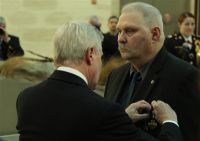WASHINGTON, Feb. 11, 2011 — Nearly 45 years after he saved almost an entire company of fellow Marines in Vietnam, a Marine Corps veteran was formally recognized today for his actions.
Navy Secretary Ray Mabus presented Ned E. Seath with the Navy Cross — the second-highest award a Marine can receive for valor — in a ceremony at the National Museum of the Marine Corps in Quantico, Va.
Then a lance corporal, Seath was serving as a machine gun team leader with the 3rd Marine Division’s Company K, 3rd Battalion, 4th Marine Regiment, when he halted an assault of North Vietnamese soldiers July 16, 1966, using an M‑60 machine gun he reassembled from spare parts. But his story of heroism was tucked away when his service in the Marine Corps ended.
Seven years ago, his story resurfaced during a battalion reunion, leading to a movement started by Bill Hutton, who served with Seath, to recognize Seath’s heroism.
“All I could think was they’re going to be overrun us and they were going to kill us all,” Seath said. “I had Hutton and Bennett on my flanks with fixed bayonets holding them off. They gave me a good two more minutes to make one good gun.”
His unit, one of the four Marine battalions in Task Force Delta, was called into action to support Operation Hastings, an effort to push the a North Vietnamese army division out of South Vietnam’s Quang Tri province. The company’s mission was to establish a blocking position in the middle of an enemy trail network.
Led by platoon commander David Richwine, now a retired major general, Seath’s role was to provide machine-gun fire to aid in disrupting North Vietnamese army activity in the area. After landing, Seath’s company soon came upon a reinforced enemy platoon waiting for the Marines in a defensive position.
During the ensuing onslaught, Seath moved to obtain a disabled machine gun from a wounded Marine nearby, building an operational M‑60 machine gun out of two inoperative weapons, and he quickly returned devastatingly accurate fire to the oncoming enemy.
One of the weapons simply malfunctioned, Seath said, while another fire team a few fighting positions away could provide only semi-automatic fire. He pulled out a clean poncho, grabbed some grease and a brush, and went to work on the two weapons to craft the one the Marines so desperately needed.
Richwine said Seath began laying down machine-gun fire in the prone position. As his field of fire became obstructed by enemy casualties, he completely disregarded his safety as he knelt at first and eventually stood up, fully exposed to enemy fire, to continue repelling the enemy’s advance.
“Everyone was fighting for their lives,” Richwine said, noting that the advancing enemy was closing in. “Several Marines even had affixed bayonets. Seath was providing well-aimed, disciplined machine-gun fire, which ultimately killed their attack. It was a combined effort stopping the enemy, but Seath was the guy with the tool to do the job best -– all while in the dark.”
All that illuminated the sky that night was sporadic flairs from passing aircraft, but what lit the battlefield was the tracer rounds — red streaks from the Marines and green streaks from the North Vietnamese army, Richwine said.
“If it weren’t for Ned Seath, I’d be buried right now … in Arlington [National Cemetery],” said Hutton, who fought alongside Seath during that battle. “We were surrounded and outnumbered. But Ned didn’t quit. He went above and beyond the call of duty. He saved a company of Marines.”
By this night, only the second night of the operation, Seath was very familiar of the possibility of dying on the battlefield for the sake of his fellow Marines. Just 24 hours earlier, he had rushed to the aid of two wounded Marines under heavy machine-gun fire that already had claimed the lives of two Marines, and dragged them to safety. For these actions, he received the Bronze Star Medal with a “V” device for valor, which was presented along with his Navy Cross.
“What Ned went through — what he did — is emblematic of the Marine Corps,” Mabus said. “This is one of the biggest honors I have. Ned Seath is a hero.”
Source:
U.S. Department of Defense
Office of the Assistant Secretary of Defense (Public Affairs)

 von
von 